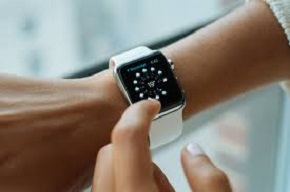Wearables and wellbeing in buildings
In October 2018, BSRIA launched a White Paper on ‘Wearables and wellbeing in buildings - the story so far’.
The general consensus emerging from the White Paper is that, while there is substantial potential for the deployment of wearables, there are also significant technical, social and legal challenges.
It is also clear that there is little evidence of any practical solutions linking wearables to HVAC or building systems in general that are already in operation, apart from in niche areas such as wearable security fobs.
The paper looks at the kinds of wearable technologies currently available and at what needs to happen to bring viable solutions to market that link wearables and building systems in a useful way.
A wearable is taken to be an article, a device or an item of clothing which can be worn by a human, or possibly carried as an implant, which has a degree of intelligence built into it and can potentially communicate with the Internet of Things (IoT), either directly or indirectly – for example, via a Bluetooth connection to a smart phone. Animals can also wear devices or carry implants which could in some cases be relevant to building management, for example, in the case of an assistance dog or guide dog.
Examples include: smart watches, which can record various metrics of the wearer’s health and behaviour, smart glasses that can provide visual imagery, smart clothing, which can provide heating, enhanced visibility or greater sensitivity, smart hearing aids and even smart jewellery, which can, for example, issue alerts to the wearer.
Henry Lawson, BSRIA’s Senior Market Research Consultant, BSRIA’s World Market Intelligence Division said:
“At present, the practical applications of wearables are strongly focused on health and fitness, from the monitoring of basic health metrics such as exercise taken and heart rates, through to the tracking of specific and sometimes serious medical problems. There is also some overlap between health and ‘leisure’ with goals such as relaxation.
"There is growing evidence to support the common sense view that people who are healthier and happier are likely to be more productive and that this can feed into a positive financial return. There is also evidence that buildings can affect wellbeing positively or negatively both through their design and through the functionality and efficiency of the systems running to heat, cool and ventilate and light the building.
“There needs to be a means of collecting, calibrating and analysing data from a lot of different wearable devices. This immediately raises issues of consent, privacy and data security, as data relating to physical health is likely to be highly sensitive and data relating to mental states even more so. People in buildings, whether employees, customers or visitors, need a motive to share their data.
"Ironically, when it comes to emerging technology of this kind, one thing that the past has taught us is that some of the most important and far reaching applications for wearables, both inside and outside buildings, are likely to be ones that we have not even thought of yet.”
‘Wearables & wellbeing in buildings – the story so far’ White Paper published in 2018 is available (as a free copy) in combination with the purchase of additional BSRIA studies. It is a sequel to the BSRIA White Paper 'Trends towards wearables and wellbeing in buildings – a threat or opportunity for the HVAC industry?' published in 2017.
You can access the report at: https://www.bsria.co.uk/accounts/register/?file=wp8-2018-wearables-and-wellbeing-in-buildings.pdf
This article was originally published here by BSRIA on 18 October 2018.
--BSRIA
[edit] Related articles on Designing Buildings Wiki
Featured articles and news
Key points for construction at a glance with industry reactions.
Functionality, visibility and sustainability
The simpler approach to specification.
Architects, architecture, buildings, and inspiration in film
The close ties between makers and the movies, with our long list of suggested viewing.
SELECT three-point plan for action issued to MSPs
Call for Scottish regulation, green skills and recognition of electrotechnical industry as part of a manifesto for Scottish Parliamentary elections.
UCEM becomes the University of the Built Environment
Major milestone in its 106-year history, follows recent merger with London School of Architecture (LSE).
Professional practical experience for Architects in training
The long process to transform the nature of education and professional practical experience in the Architecture profession following recent reports.
A people-first approach to retrofit
Moving away from the destructive paradigm of fabric-first.
International Electrician Day, 10 June 2025
Celebrating the role of electrical engineers from André-Marie Amperè, today and for the future.
New guide for clients launched at Houses of Parliament
'There has never been a more important time for clients to step up and ...ask the right questions'
The impact of recycled slate tiles
Innovation across the decades.
EPC changes for existing buildings
Changes and their context as the new RdSAP methodology comes into use from 15 June.
Skills England publishes Sector skills needs assessments
Priority areas relating to the built environment highlighted and described in brief.
BSRIA HVAC Market Watch - May 2025 Edition
Heat Pump Market Outlook: Policy, Performance & Refrigerant Trends for 2025–2028.
Committing to EDI in construction with CIOB
Built Environment professional bodies deepen commitment to EDI with two new signatories: CIAT and CICES.
Government Grenfell progress report at a glance
Line by line recomendation overview, with links to more details.
An engaging and lively review of his professional life.
Sustainable heating for listed buildings
A problem that needs to be approached intelligently.
50th Golden anniversary ECA Edmundson apprentice award
Deadline for entries has been extended to Friday 27 June, so don't miss out!
CIAT at the London Festival of Architecture
Designing for Everyone: Breaking Barriers in Inclusive Architecture.
Mixed reactions to apprenticeship and skills reform 2025
A 'welcome shift' for some and a 'backwards step' for others.




























